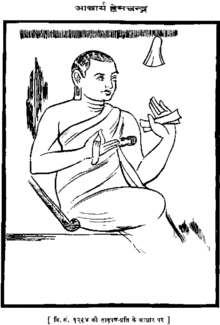Acharya Hemachandra Suri | |
|---|---|
 Drawing of Hemchandra based on Vikram Samvat 1294 palm leaf | |
| Official name | Acharya Hemchandra Suri |
| Personal | |
| Born | Changadeva c. 1088 (see notes) |
| Died | c. 1173 (see notes) |
| Religion | Jainism |
| Parent(s) | Chachinga, Pahini |
| Sect | Śvētāmbara |
| Notable work(s) | Siddha-Hema-Śabdanuśāśana, Yogasastra |
| Religious career | |
| Initiation | Somchandra Khambhat by Devchandrasuri |
| Post | Acharya (Jainism) |
| Part of a series on |
| Jainism |
|---|
 |
Hemachandra was a 12th century (c. 1088 – c. 1172/1173 CE) Śvetāmbara Jain acharya,scholar, poet, mathematician, philosopher, yogi, grammarian,[1] law theorist,[2][3] historian,[4] lexicographer, rhetorician, logician, and prosodist.[5] Noted as a prodigy by his contemporaries, he gained the title kalikālasarvajña, "the knower of all knowledge in his times" and father of the Gujarati language.
Born as Changadeva, he was ordained in the Śvētāmbara school of Jainism in 1110 and took the name Somachandra. In 1125 he became an adviser to King Kumarapala and wrote Arhanniti, a work on politics from a Jain perspective. He also produced Trishashti-shalaka-purusha-charita (“Deeds of the 63 Illustrious Men”), a Sanskrit epic poem on the history of important figures of Jainism. Later in his life, he changed his name to Hemachandra.
- ^ Datta, Amaresh (1987). Encyclopaedia of Indian Literature: A-Devo. Sahitya Akademi. pp. 15–16. ISBN 978-81-260-1803-1.
- ^ Flügel, Peter. "A Short History of Jaina Law": 5.
{{cite journal}}: Cite journal requires|journal=(help) - ^ "Hemachandra | Jaina author | Britannica". www.britannica.com. Retrieved 7 February 2022.
- ^ Singh, Upinder (2008). A History of Ancient and Early Medieval India: From the Stone Age to the 12th Century. Pearson Education India. p. 241. ISBN 978-81-317-1677-9.
- ^ Datta, Amaresh (1987). Encyclopaedia of Indian Literature: A-Devo. Sahitya Akademi. p. 15. ISBN 978-81-260-1803-1.